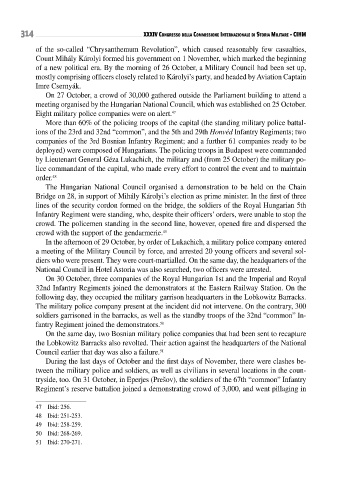Page 314 - Conflitti Militari e Popolazioni Civili - Tomo I
P. 314
314 XXXIV Congresso della CommIssIone InternazIonale dI storIa mIlItare • CIHm
of the so-called “Chrysanthemum Revolution”, which caused reasonably few casualties,
Count Mihály Károlyi formed his government on 1 November, which marked the beginning
of a new political era. By the morning of 26 October, a Military Council had been set up,
mostly comprising officers closely related to Károlyi’s party, and headed by Aviation Captain
Imre Csernyák.
On 27 October, a crowd of 30,000 gathered outside the Parliament building to attend a
meeting organised by the Hungarian National Council, which was established on 25 October.
Eight military police companies were on alert. 47
More than 60% of the policing troops of the capital (the standing military police battal-
ions of the 23rd and 32nd “common”, and the 5th and 29th Honvéd Infantry Regiments; two
companies of the 3rd Bosnian Infantry Regiment; and a further 61 companies ready to be
deployed) were composed of Hungarians. The policing troops in Budapest were commanded
by Lieutenant General Géza Lukachich, the military and (from 25 October) the military po-
lice commandant of the capital, who made every effort to control the event and to maintain
order. 48
the Hungarian National Council organised a demonstration to be held on the Chain
Bridge on 28, in support of Mihály Károlyi’s election as prime minister. In the first of three
lines of the security cordon formed on the bridge, the soldiers of the Royal Hungarian 5th
Infantry Regiment were standing, who, despite their officers’ orders, were unable to stop the
crowd. the policemen standing in the second line, however, opened fire and dispersed the
crowd with the support of the gendarmerie. 49
In the afternoon of 29 October, by order of Lukachich, a military police company entered
a meeting of the Military Council by force, and arrested 20 young officers and several sol-
diers who were present. They were court-martialled. On the same day, the headquarters of the
National Council in Hotel Astoria was also searched, two officers were arrested.
On 30 October, three companies of the Royal Hungarian 1st and the Imperial and Royal
32nd Infantry Regiments joined the demonstrators at the Eastern Railway Station. On the
following day, they occupied the military garrison headquarters in the Lobkowitz Barracks.
The military police company present at the incident did not intervene. On the contrary, 300
soldiers garrisoned in the barracks, as well as the standby troops of the 32nd “common” In-
fantry Regiment joined the demonstrators. 50
On the same day, two Bosnian military police companies that had been sent to recapture
the Lobkowitz Barracks also revolted. Their action against the headquarters of the National
Council earlier that day was also a failure. 51
During the last days of October and the first days of November, there were clashes be-
tween the military police and soldiers, as well as civilians in several locations in the coun-
tryside, too. On 31 October, in Eperjes (Prešov), the soldiers of the 67th “common” Infantry
Regiment’s reserve battalion joined a demonstrating crowd of 3,000, and went pillaging in
47 Ibid: 256.
48 Ibid: 251-253.
49 Ibid: 258-259.
50 Ibid: 268-269.
51 Ibid: 270-271.

